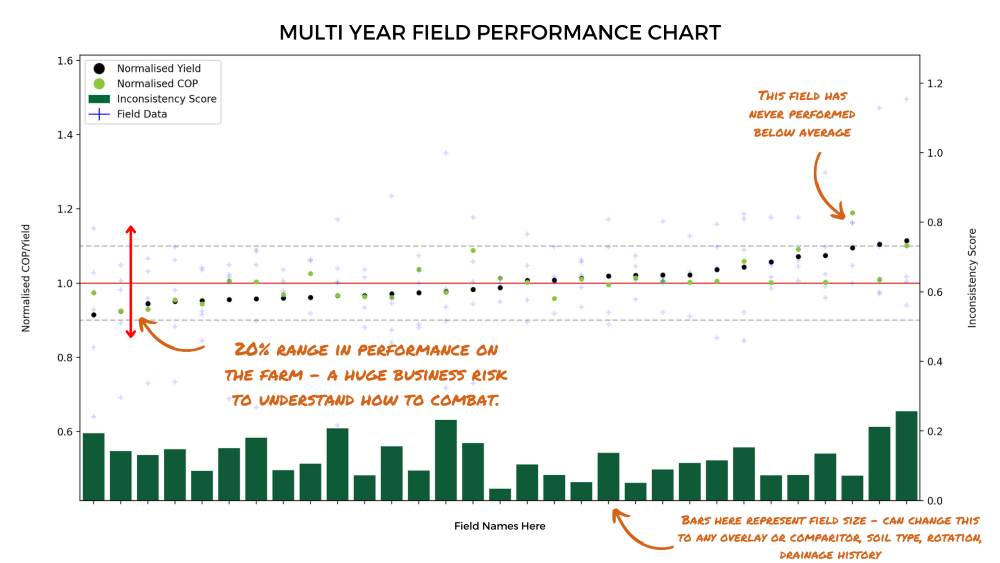What the agricultural industry can learn from other sectors to navigate the road ahead - a personal view.
My take on the risks of farming, personal risk appetite, and how access to on-farm analytics can drive effective decision making - by Rupert Harlow.
I want to draw some comparisons on how picking an investment (stock and shares), in many ways, is no different to picking next year’s crop; and how, with more information that process can be improved upon. Before joining YAGRO I worked in private client wealth management where the decision-making around investments was a rigorous and onerous task. Moving into agriculture, I was surprised at the lack of access to and how limited the information available was to aid effective decision making.
Farming is an inherently risky business with a whole raft of variables that a farmer or grower has to take into account when making a decision or what to grow, where, when and how.
When you start investing for a client, a natural first question is 'what is the investor’s requirements for that stock? What do you want to get out of it? Is this for income, capital growth or a hybrid of the two?' I don’t see this as being any different to picking a crop, is this a cash crop such as wheat or barley? Or is there an addition reason for your choice? For example growing beans for fixing nitrogen and improving the soil for the following season. Understanding the range of benefits of adding that crop into the rotation and how it helps the farm’s long-term performance we need to account for the ‘non-cash’ benefits and factor those into the decisions in a way that is measurable and comparable to the purely ‘cash crops’ decision process.
Then, what’s the risk profile of the farm? If these were investments, is the investor financially able to bear investing in a high-risk stock; likewise, to what extent does he or she have a desire to take that risk? Often financial position and mindset can be at odds with each other – a person may not be able to afford to take a risk but they want to do so. How often in farming is risk appetite and one’s ability to financially bear risk explored in great detail? I would suggest that if there is a risk profile, its not shared with all involved parties to keep everybody on the same page. We all know oilseed rape and peas can be high risk crops, especially in recent years, but they do offer high rewards when growing conditions and programmes are optimised to minimise those risks. If we add in multi-year averaged field performance to highlight the range of performance between fields (often varying up to 40%), we can have a better understanding of internal volatility of field production. Combine that with crop and variety data to understand the range of and expected costs and yields for a crop, we can start to predict expected outcomes and start to manage our decision-making and willingness to “take a chance” as a business risk, and perhaps mitigate that risk with other decisions we might make to perhaps level out the peaks and troughs of farming.

Looking at the financial software we had on each and every desk, the company spent vast of money to aid with making the most informed decision (Bloomberg licences are circa £20,000 per year per terminal with more basic solutions at around £10,000 per person per year). Expensive tools and requiring a fair amount of learning to master them; but a necessary requirement for the job. These systems hold vast amounts of data on companies. Taking John Deere as an example: all financially related articles ever written about the company are available to view or with a link to read in more detail, as are the company’s financial records going back to the dawn of time; you can do your research in huge depth in one place. There is up to the second pricing information, current and historic dividend details; effectively every piece of information you could want on the company in one piece of software.
I was surprised when I came into the agricultural industry: there is a huge amount of information and research, but it’s spread out, with multiple research bodies each producing information which is scattered in different formats in different places, uncollated and therefore nigh on impossible for most to compare with any accuracy or impartiality. We need to collate, structure, and produce analytics for all farms. A tool that can ingest data from any source. We need a tool to span the whole industry…
Understanding the previous performance and having that research available in one place saves a huge amount of time as well as helping build that clear understanding of the stock or in our case the crop. We can do historical analysis to find better approaches, spot trends and inconsistencies, and plan future seasons.
An investment approach or discipline I always found fascinating is Chartism where investors use charts to forecast the next move of that stock. The same type of approach could be taken with fields, crops and varieties, looking at massive data sets to see if yields are stagnant, improving, filtered by soil type, weather conditions, geographical area, technique of establishment; the list is endless. Even simple comparisons can really help: imagine having a chart just showing yield vs drill date for all KWS Siskin for the past 10 years… That would be of MASSIVE benefit to farms in terms of understanding optimal drill dates, and would also help to understand if there is a need to change to more appropriate machinery to achieve those optimum dates. Such analysis could even be used as a business case to approach a bank for financing…
This hardly scrapes the surface and is just a viewpoint, comparing one tiny element within a fraction of a behemoth of an industry.
In summary, with the agricultural sector going through a massive change at present, not all the answers will come introspectively. Why not plagiarise the best bits of other industries to make ours the best!

